 UPDATED REPORT – June 1, 2024 – HYBRID DIGITAL PIANOS | REVIEW & REPORT | 10 Things You Must Know Before You Buy! | What are hybrid digital pianos? Why are they becoming more desirable to own and how much do they cost? “Hybrid” digital pianos in 2024 are essentially digital electric pianos with partial or complete acoustic piano key actions or wood parts and/or or wooden sound producing components in them.
UPDATED REPORT – June 1, 2024 – HYBRID DIGITAL PIANOS | REVIEW & REPORT | 10 Things You Must Know Before You Buy! | What are hybrid digital pianos? Why are they becoming more desirable to own and how much do they cost? “Hybrid” digital pianos in 2024 are essentially digital electric pianos with partial or complete acoustic piano key actions or wood parts and/or or wooden sound producing components in them.The current hybrid furniture cabinet digital pianos are the following 31 models: Yamaha Clavinova CLP-745, CLP-775, CLP-785, CLP-795GP, CVP-805, CVP-809, CVP-809GP, Yamaha AvantGrand NU1XA, N1X, N2, and N3X. Kawai Concert Artist CA401, CA501, CA701, CA901, Kawai Novus NV5s, NV10s. Roland HP704, LX5, LX6, LX9, GP6, GP9. Casio GP-310, GP-510, PX-S5000, PX-S6000, PX-S7000, AP-S450, AP-550, AP-750, and Dexibell H10C, H10MG. The word “hybrid” means a combination of at least 2 different technologies or opposite types of construction (parts) combined and used in one product.
A dictionary definition of the word “hybrid” states the following: “having or produced by a combination of two or more distinct elements marked by heterogeneity in origin, composition, or appearance.” A 2nd dictionary definition of hybrid says: “having two different types of components performing essentially the same function.”
What does the word “Hybrid” mean in Digital Pianos?
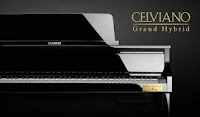 The word “hybrid” has especially been used to describe popular vehicles that some people drive which use both electricity and gasoline to power that vehicle. There are definitely benefits to this hybrid vehicle technology and the Toyota Prius has been one of the more well known names out there for hybrid vehicles. There are more and more hybrid vehicles on the road along with all electric vehicles, and that segment of the vehicle industry is continuing to grow. When it comes to digital pianos, the word hybrid is somewhat over-used and not as defined and with regard to function, technology, and construction of the piano.
The word “hybrid” has especially been used to describe popular vehicles that some people drive which use both electricity and gasoline to power that vehicle. There are definitely benefits to this hybrid vehicle technology and the Toyota Prius has been one of the more well known names out there for hybrid vehicles. There are more and more hybrid vehicles on the road along with all electric vehicles, and that segment of the vehicle industry is continuing to grow. When it comes to digital pianos, the word hybrid is somewhat over-used and not as defined and with regard to function, technology, and construction of the piano.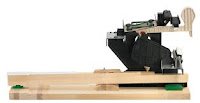 Although generally speaking “hybrid” digital pianos have a wooden part or some other organic component in them which draws similarities to an acoustic piano in some way, the digital piano manufacturers have not agreed upon a real definition for the word “hybrid” when it comes to digital pianos. So it’s anyone’s best guess as to what they really mean when they use the word “hybrid” to describe the models they produce. It could mean a wood action part(s) has been added to the key action, a partial or full wooden soundboard has been installed, resin and carbon fiber parts added in the key action, wood speakers, etc…you just don’t know what is in the “hybrid” piano unless you read the specifications closely and then also have a good knowledge of acoustic pianos.
Although generally speaking “hybrid” digital pianos have a wooden part or some other organic component in them which draws similarities to an acoustic piano in some way, the digital piano manufacturers have not agreed upon a real definition for the word “hybrid” when it comes to digital pianos. So it’s anyone’s best guess as to what they really mean when they use the word “hybrid” to describe the models they produce. It could mean a wood action part(s) has been added to the key action, a partial or full wooden soundboard has been installed, resin and carbon fiber parts added in the key action, wood speakers, etc…you just don’t know what is in the “hybrid” piano unless you read the specifications closely and then also have a good knowledge of acoustic pianos.
Hybrid Key Actions
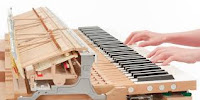 A fully hybrid piano moving key action in a digital piano has nearly all the hundreds (and thousands) of moving action parts of a real upright or grand piano including individual properly weighted keys so that it really does feel like playing an acoustic upright or grand piano with regard to the moving keys themselves…hence the name hybrid “upright” or “grand piano.” It doesn’t get more realistic than that in terms of key action unless you purchase a real acoustic grand piano with the inclusion of felt hammers touching and muting real strings along with a real una-corda soft pedal. A fully hybrid upright piano moving key action has almost all of the hundreds (and sometimes thousands) of moving organic parts of a real upright piano key action and produces the key movement and key response of a real acoustic upright piano and it does not get more natural than that unless you buy a real acoustic upright piano which would have the damper mechanism dampening real strings and felt hammers striking real strings.
A fully hybrid piano moving key action in a digital piano has nearly all the hundreds (and thousands) of moving action parts of a real upright or grand piano including individual properly weighted keys so that it really does feel like playing an acoustic upright or grand piano with regard to the moving keys themselves…hence the name hybrid “upright” or “grand piano.” It doesn’t get more realistic than that in terms of key action unless you purchase a real acoustic grand piano with the inclusion of felt hammers touching and muting real strings along with a real una-corda soft pedal. A fully hybrid upright piano moving key action has almost all of the hundreds (and sometimes thousands) of moving organic parts of a real upright piano key action and produces the key movement and key response of a real acoustic upright piano and it does not get more natural than that unless you buy a real acoustic upright piano which would have the damper mechanism dampening real strings and felt hammers striking real strings.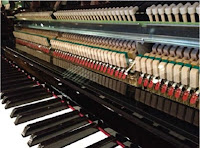 It also needs to be said that an upright piano key action is noticeably different than a grand piano key action and is not preferred by advanced pianists as compared to a grand piano. However, the acoustic upright piano version costs quite a bit less money than a grand piano and it takes up a lot less space too, and those are the 2 primary reasons why someone would choose an upright piano over a grand piano. It just depends on what you are after and how much money (and space in your room) you want to invest in with regard to your piano playing experience and budget.
It also needs to be said that an upright piano key action is noticeably different than a grand piano key action and is not preferred by advanced pianists as compared to a grand piano. However, the acoustic upright piano version costs quite a bit less money than a grand piano and it takes up a lot less space too, and those are the 2 primary reasons why someone would choose an upright piano over a grand piano. It just depends on what you are after and how much money (and space in your room) you want to invest in with regard to your piano playing experience and budget.
There is no question that playing more complex piano music such as classical, jazz, etc will come out better with more even and consistent musical expression and key action response when playing on a grand piano as opposed to an upright piano, and this is true of any brand. That’s why you’ll never see an accomplished pro pianist play an upright piano in concert. However, some of the tall upright pianos actually rival the sound of a smaller grand piano so it’s not the sound that makes the bigger difference…it’s the key action (and the pedaling) and the way it feels and how it moves that will affect your playing technique and the way you play.
Piano Sound Reproduction in Acoustic Pianos
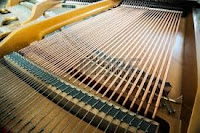 Speaking of piano sound, the strings inside the piano are what vibrates when the hammers strike the strings as you are playing a piano and that’s where each of the 88 notes comes from when you are playing each black & white key. I am stating the “obvious” for many of you out there who know these things but for some people, you may not know how a piano actually works so I find it useful to be as informative as possible. When those piano strings vibrate they only make a very small sound by themselves. They are just copper and wire so they need to be “amplified” to be heard and that amplifier is called the “soundboard.” Every acoustic stringed instrument has a wooden soundboard (see picture) and that board “amplifies” the sound of the strings in a special way so that your music can be heard loud and clear.
Speaking of piano sound, the strings inside the piano are what vibrates when the hammers strike the strings as you are playing a piano and that’s where each of the 88 notes comes from when you are playing each black & white key. I am stating the “obvious” for many of you out there who know these things but for some people, you may not know how a piano actually works so I find it useful to be as informative as possible. When those piano strings vibrate they only make a very small sound by themselves. They are just copper and wire so they need to be “amplified” to be heard and that amplifier is called the “soundboard.” Every acoustic stringed instrument has a wooden soundboard (see picture) and that board “amplifies” the sound of the strings in a special way so that your music can be heard loud and clear.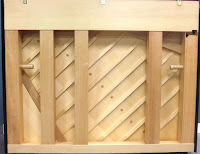 It really is not just a plain wooden board in a musical instrument like a piano, but actually a complex and exacting design, construction, and type of wood to bring out the sound of the strings in a beautiful and powerful way that will resonate all around you and within the room you are in. This is true not only of upright and grand pianos but also for acoustic guitars, and other acoustic stringed instruments, etc. Without the wood soundboard and interior chamber of the acoustic piano to amplify the piano strings in an acoustic piano, you would have no sound and your acoustic piano would not really be playable.
It really is not just a plain wooden board in a musical instrument like a piano, but actually a complex and exacting design, construction, and type of wood to bring out the sound of the strings in a beautiful and powerful way that will resonate all around you and within the room you are in. This is true not only of upright and grand pianos but also for acoustic guitars, and other acoustic stringed instruments, etc. Without the wood soundboard and interior chamber of the acoustic piano to amplify the piano strings in an acoustic piano, you would have no sound and your acoustic piano would not really be playable.
It is this marriage of strings and wood along with steel, copper, iron, and some other organic parts which makes an acoustic piano work in the way that it does and gives you that natural piano playing experience.
Piano Sound Reproduction in Digital Pianos
 |
| Kawai CA901 soundboard |
In a digital piano, the sound is generated digitally from a piano sound chip (sound engine) and is then amplified electronically through digital power amplifiers and the sound comes out through speakers so you don’t need a wood soundboard in the piano to help produce the piano sound because the electronics and speakers do that job. However, there is one brand which has added a real acoustic soundboard made of spruce-wood in 2 of its digital pianos which then gives the added “organic” elements of natural acoustic amplification along with speakers and digital amplifiers in those digital pianos. That brand is Kawai and the 2 new digital hybrid pianos which include a wooden soundboard is the CA901 and NV5s upright style digital pianos. Since there are no strings in a digital piano the natural occurring vibrations in that organic soundboard need to be picked up by the attachment of special transducer microphones on the soundboard so that the natural wood soundboard tone can be heard coming out of the additional speakers in the digital piano.
In other words, the digital piano has digital amplifiers which send the digital piano sound out of the speakers just like all other digital pianos, but that same piano also has a real wooden soundboard (similar to an acoustic upright piano) with attached special transducer microphones on that wood soundboard to help get that natural sound to be heard. It’s a fascinating process and one which works well and you can actually hear the difference with and without that soundboard.
Pedaling Operation & Response in Acoustic Pianos
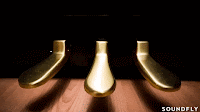 Another important aspect of any “acoustic” piano are the 3 pedals attached to the piano near the bottom center of the cabinet. Those 3 moving pedals are mechanical and they are connected moving wooden and metal parts that attach to those pedals which then controls the sustain, sostenuto, and soft (una-corda) pedal functions. This has a big impact on your music and how it comes out of the piano while playing a song. In a regular acoustic piano there are over 200 strings that create the piano sound when the keys move and the hammers strike the strings. Depending on the notes you play, specific strings are struck by the hammers inside the piano and those strings vibrate and sustain freely as long as you have a key pressed down or you are holding down your damper-sustain pedal.
Another important aspect of any “acoustic” piano are the 3 pedals attached to the piano near the bottom center of the cabinet. Those 3 moving pedals are mechanical and they are connected moving wooden and metal parts that attach to those pedals which then controls the sustain, sostenuto, and soft (una-corda) pedal functions. This has a big impact on your music and how it comes out of the piano while playing a song. In a regular acoustic piano there are over 200 strings that create the piano sound when the keys move and the hammers strike the strings. Depending on the notes you play, specific strings are struck by the hammers inside the piano and those strings vibrate and sustain freely as long as you have a key pressed down or you are holding down your damper-sustain pedal.The sustain (aka: damper pedal) is the most important of the 3 pedals because using that pedal is what gives you a beautiful lush tone when the pedal is down and the piano sound continues to sustain and the strings vibrate and resonate and create sympathetic vibrations with other strings inside the piano along with subtle overtones and other organic tonal elements being heard. Sustained resonating strings at different times when you are playing a song adds a full natural tone that enhances the entire musical experience and outcome.
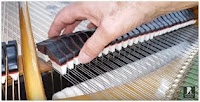 The way a sustain (aka: damper) pedal works is that it is connected by parts to a long damper rail inside an acoustic piano where the individual dampers are resting on the rail. When the damper pedal is pushed down by your foot then those dampers in the piano are pushed up and away from all of the over 200 strings and those strings vibrate freely over a long period of time while the pedal is held down. This is what helps create long, sustained piano tones that make your music lush and beautiful. Also, every time you press down a key and hold down that key, that specific damper on a specific note will release the string to be able to freely sustain which holds out that piano sound until you release that key. Once the damper pedal or specific key is released, then the damper (s) fall back onto the strings and the sustained note immediately stops playing.
The way a sustain (aka: damper) pedal works is that it is connected by parts to a long damper rail inside an acoustic piano where the individual dampers are resting on the rail. When the damper pedal is pushed down by your foot then those dampers in the piano are pushed up and away from all of the over 200 strings and those strings vibrate freely over a long period of time while the pedal is held down. This is what helps create long, sustained piano tones that make your music lush and beautiful. Also, every time you press down a key and hold down that key, that specific damper on a specific note will release the string to be able to freely sustain which holds out that piano sound until you release that key. Once the damper pedal or specific key is released, then the damper (s) fall back onto the strings and the sustained note immediately stops playing.
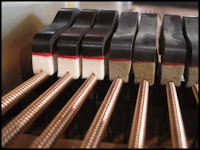 The damper pedal mechanism has to work in a precise manner to operate properly so that your music sounds good. The center pedal is called the sostenuto pedal and does partial sustaining for certain notes in specific songs and that pedal isn’t used much at all these days. In a grand piano key action the left pedal actually physically moves the entire keyboard over to the left just a little bit so that not all of the strings are being struck by the hammers when you’re playing. This function reduces the overall volume of the piano and makes it a bit quieter and you can use this pedal at various times in the song if you need the overall volume to be softer at that point. But even the soft pedal is not used very much by most recreational players. Regardless, those pedals (especially the damper-sustain pedal) are critical in the outcome of the song you are playing if you want the most musical expression possible.
The damper pedal mechanism has to work in a precise manner to operate properly so that your music sounds good. The center pedal is called the sostenuto pedal and does partial sustaining for certain notes in specific songs and that pedal isn’t used much at all these days. In a grand piano key action the left pedal actually physically moves the entire keyboard over to the left just a little bit so that not all of the strings are being struck by the hammers when you’re playing. This function reduces the overall volume of the piano and makes it a bit quieter and you can use this pedal at various times in the song if you need the overall volume to be softer at that point. But even the soft pedal is not used very much by most recreational players. Regardless, those pedals (especially the damper-sustain pedal) are critical in the outcome of the song you are playing if you want the most musical expression possible.
Pedaling Operation & Response in Hybrid Digital Pianos
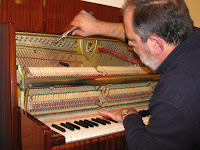 I mention all that with regard to the pedals, especially the damper pedal, because in a “hybrid” digital piano there are no strings as I said earlier. That’s the really a big benefit of a hybrid digital piano…the sound is generated by the digital piano sound technology which then is heard through the internal speaker system on nearly all digital pianos. The downside of a stringed acoustic piano is that it always needs tuning which can cost you thousands of dollars over the life of a piano. The tuning pins in an acoustic piano pin-block which hold the strings in place can possibly start slipping over time and cracks can form in the wood pin-block depending on the piano and weather conditions. When a piano technician tunes the piano it may not stay in tune if there are problems in the wood pin-block holding the strings in place.
I mention all that with regard to the pedals, especially the damper pedal, because in a “hybrid” digital piano there are no strings as I said earlier. That’s the really a big benefit of a hybrid digital piano…the sound is generated by the digital piano sound technology which then is heard through the internal speaker system on nearly all digital pianos. The downside of a stringed acoustic piano is that it always needs tuning which can cost you thousands of dollars over the life of a piano. The tuning pins in an acoustic piano pin-block which hold the strings in place can possibly start slipping over time and cracks can form in the wood pin-block depending on the piano and weather conditions. When a piano technician tunes the piano it may not stay in tune if there are problems in the wood pin-block holding the strings in place.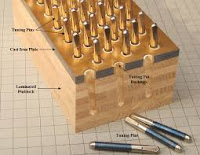 The acoustic piano will also likely require other maintenance over time such as fixing or replacing dampers or other action parts, the acoustic piano cannot be played at low volumes using a master volume control (it has no volume control like digital pianos), and you cannot use headphones in a traditional acoustic piano for playing privately like you can in a digital piano. Also, without the stings in a piano there is no reason to have the felt hammers that are associated with real acoustic pianos because there are no strings for the hammers to strike. Instead, the hammers are really metal rods that take the place of felt hammers (see picture) and the speed and movement of those rods are detected by optical sensors which then trigger the piano sound in an appropriate way.
The acoustic piano will also likely require other maintenance over time such as fixing or replacing dampers or other action parts, the acoustic piano cannot be played at low volumes using a master volume control (it has no volume control like digital pianos), and you cannot use headphones in a traditional acoustic piano for playing privately like you can in a digital piano. Also, without the stings in a piano there is no reason to have the felt hammers that are associated with real acoustic pianos because there are no strings for the hammers to strike. Instead, the hammers are really metal rods that take the place of felt hammers (see picture) and the speed and movement of those rods are detected by optical sensors which then trigger the piano sound in an appropriate way.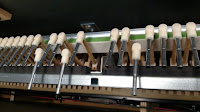 Although there is an actual damper rail in the 2 Kawai Novus hybrid digital pianos to give more of a natural feeling to using the pedals, and there are no felt dampers because there are no actual strings to dampen. The damper rail is there to give more realism to the feeling of the key action and pedal movement as compared to a traditional acoustic piano. In a hybrid digital piano, without an actual damper rail mechanism the pedals overall still feel good to use and the response is fine for most people who play at recreational levels. But if you are at a more advanced piano playing level then a hybrid digital piano with a damper rail along with a full blown wood key action would be more appropriate and helpful. However, those models do not come “cheap.” You typically get what you pay for and it will cost you more money to get to that level of digital piano.
Although there is an actual damper rail in the 2 Kawai Novus hybrid digital pianos to give more of a natural feeling to using the pedals, and there are no felt dampers because there are no actual strings to dampen. The damper rail is there to give more realism to the feeling of the key action and pedal movement as compared to a traditional acoustic piano. In a hybrid digital piano, without an actual damper rail mechanism the pedals overall still feel good to use and the response is fine for most people who play at recreational levels. But if you are at a more advanced piano playing level then a hybrid digital piano with a damper rail along with a full blown wood key action would be more appropriate and helpful. However, those models do not come “cheap.” You typically get what you pay for and it will cost you more money to get to that level of digital piano.Downsides of Acoustic Pianos
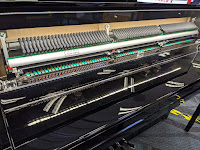 Again, the point of a “hybrid” digital piano is to try to re-create the acoustic piano playing experience without the downsides of an acoustic piano. These “downsides” would include the need for strings which have to be constantly tuned over the life of the piano along with acoustic pianos always being loud in volume as well as being negatively affected by more extreme humidity levels such as too much or too little moisture in the air. Acoustic pianos are also heavy (hundreds of lbs) and difficult to move and you cannot connect them to modern technology such as interactive educational piano training through computer programs or apps on tablets connected by a USB cable, or through wireless Bluetooth or USB audio streaming which can be very useful to have.
Again, the point of a “hybrid” digital piano is to try to re-create the acoustic piano playing experience without the downsides of an acoustic piano. These “downsides” would include the need for strings which have to be constantly tuned over the life of the piano along with acoustic pianos always being loud in volume as well as being negatively affected by more extreme humidity levels such as too much or too little moisture in the air. Acoustic pianos are also heavy (hundreds of lbs) and difficult to move and you cannot connect them to modern technology such as interactive educational piano training through computer programs or apps on tablets connected by a USB cable, or through wireless Bluetooth or USB audio streaming which can be very useful to have.Know the Facts!
 The main number one point to focus on in any hybrid digital piano is the key action and how realistic it is. Following that would be the piano sound, pedaling response, and internal speaker system projection. The user interface display and all the digital features and functions in these pianos is just “frosting on the cake” as the old saying goes. So when you are shopping for a hybrid digital piano you need to focus on the things that actually make it a “hybrid” and the more that organic materials are put into a digital piano along with operating as much like an acoustic piano as possible, the more hybrid it becomes. But don’t let the word “hybrid” fool you.
The main number one point to focus on in any hybrid digital piano is the key action and how realistic it is. Following that would be the piano sound, pedaling response, and internal speaker system projection. The user interface display and all the digital features and functions in these pianos is just “frosting on the cake” as the old saying goes. So when you are shopping for a hybrid digital piano you need to focus on the things that actually make it a “hybrid” and the more that organic materials are put into a digital piano along with operating as much like an acoustic piano as possible, the more hybrid it becomes. But don’t let the word “hybrid” fool you.Some of these digital manufacturers take advantage of that word when describing their so called hybrid pianos because sometime that “marketing campaign” doesn’t line up with the reality of that piano. In other words sometimes a “hybrid” digital piano is hardly a hybrid at all…the digital piano manufacturer just wants to “sell you something” that otherwise barely exists in their product. So you need to be careful out there and know what you are doing and that’s why I have put together this report…to give you the “real scoop” on what’s going on out there in the hybrid digital piano world.
Acoustic & Trans-Acoustic Hybrid Pianos
 One more thing…there is also a piano product which takes a real full sized complete acoustic upright piano and then adds a MIDI digital piano sound module and speakers to the acoustic piano which offers you a way to have a 100% real piano in your home but with the capability of playing digital piano sounds for the main purpose of using headphones for private practice. This type of “hybrid” piano is called an acoustic hybrid and not a digital hybrid. They are made by both the Yamaha and Kawai piano companies. The way this product works is that to keep the strings from being struck by the hammers and heard, the real acoustic felt hammers do not actually touch the strings in the piano (yes, there are strings) when you play the keys.
One more thing…there is also a piano product which takes a real full sized complete acoustic upright piano and then adds a MIDI digital piano sound module and speakers to the acoustic piano which offers you a way to have a 100% real piano in your home but with the capability of playing digital piano sounds for the main purpose of using headphones for private practice. This type of “hybrid” piano is called an acoustic hybrid and not a digital hybrid. They are made by both the Yamaha and Kawai piano companies. The way this product works is that to keep the strings from being struck by the hammers and heard, the real acoustic felt hammers do not actually touch the strings in the piano (yes, there are strings) when you play the keys.
Regardless, these acoustic instruments are a lot more money than hybrid digital pianos and I am personally not a big fan of these so called acoustic hybrid pianos for the “average” player because those pianos still need regular tuning and maintenance, they are subject to physical change because of weather conditions, they are heavy instruments, and again, their prices are much higher in cost. The main advantage is that you still get a real piano but with the advantage of practicing with headphones when using the digital piano sounds.
But what I am talking about in this report are “digital” pianos which have no strings, no soundboard (on most of them), no dampers and damper rail, but they do have acoustic type (wood or partial wood) keys and/or full key actions which is the #1 most important component in any piano and that’s why “hybrid” digital pianos have become so popular in the last 10 years and they are getting better with each passing year. They are overall more realistic and natural than non-hybrid digital pianos and are in more affordable price ranges as compared with new traditional acoustic pianos.
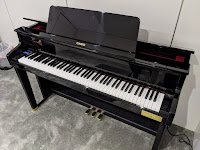 |
| Casio GP-510 Ebony Hybrid |
Casio – Casio has 8 models of hybrid digital pianos and they are called the PX-S5000 at $1199, PX-S6000 at $1799, PX-S7000 at $2499, AP-S450 at $1999, AP-550 at $2999, AP750 at $3399, GP-310 at $4299, and GP-510 at $6299. The hybrid portion of the 2 highest price Casio hybrid pianos are the physical keys made by the Bechstein Grand Piano company of Germany which offers 16″ extra long 100% all-wood grand piano white keys and also grand piano style moving hammers which are made of 100% resin and move up & down like in real grand pianos.
Even though the moving hammers in both models are not made of wood and are not organic, Casio would consider them part of their “hybrid” definition because these unusual parts are the only simulated moving grand piano style hammers of any digital piano under $8000 out there and the moving hammer simulation gives these models another “hybrid” aspect that the other digital pianos in that price range do not have.
In terms of the hybrid components in the GP-310, and GP-510 models and whether they make the piano playing experience more authentic than non-hybrid digital pianos, they definitely do that and it’s something which puts these 2 top end Casio models far beyond all the other Casio pianos in the lower price ranges, and also make them very competitive with the other major brands who make hybrid digital pianos.
 |
| Casio GP-310 white Hybrid |
The static down-weight and moving up-weight of these GP white keys are very comfortable. They move smoothly with great response, and feels like you have real acoustic grand piano keys under your fingers. The wooden black key movement is also impressive and moves very nicely. Casio really has done a remarkable job with this key action and it’s because the action is made by the famous Bechstein piano company, the GP-310 and GP-510 is really a blend of acoustic piano technology from Germany and Casio electronic technology of Japan.
The exceptions to the simulated escapement/let-off action feature is when the hybrid digital pianos use a complete wood key action with all of the moving parts such as what Yamaha uses in their AvantGrand series of hybrids and what Kawai has in their Novus hybrids. But those pianos are a lot more money than these new Casio models. So pound for pound I believe you’ll be very impressed with these new Casio hybrid digital pianos for key action, piano sound reproduction, pedaling, and digital features..
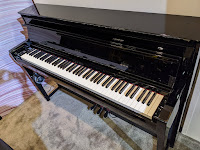 |
| Yamaha CLP-785 ebony hybrid |
Yamaha – The Yamaha brand has by far the most models that would fall into this “hybrid” category as compared to any other brand out there. This list would include models in their Clavinova series and their AvantGrand series of digital pianos. The Clavinova “hybrid” models would include the CLP-745, CLP-775, CLP-785, CLP-795GP, CSP-275, CVP-805, CVP-809, and CVP-809GP. The AvantGrand series includes the NU1XA, N1X, N2, and N3X. This adds up to a total of 12 models of digital pianos that have some type of wood or other organic components in them. The more wood and/ore organic parts are part of a particular model, the closer it gets to a real acoustic piano and therefore the more “hybrid” it becomes.
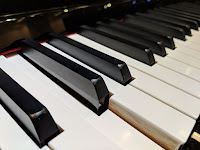 In the Yamaha Clavinova CLP-745 and CSP-170, all the white keys are made of partial wood but the black keys are not made of wood at all…they are still 100% plastic, which is fine, but they are not wood. The length of the white wood keys are shorter as opposed to grand piano keys which are longer. The CLP-745 has a key balance and movement from the front of each white key to the back of the key more like an upright acoustic piano. However, on the Clavinova CLP-775 (not available in the US), CLP-785, CLP-795GP, CVP-805, CVP-809, and CVP-809GP, all of those wooden white keys are longer in length than the wooden keys in the CLP-745 and CSP-275.
In the Yamaha Clavinova CLP-745 and CSP-170, all the white keys are made of partial wood but the black keys are not made of wood at all…they are still 100% plastic, which is fine, but they are not wood. The length of the white wood keys are shorter as opposed to grand piano keys which are longer. The CLP-745 has a key balance and movement from the front of each white key to the back of the key more like an upright acoustic piano. However, on the Clavinova CLP-775 (not available in the US), CLP-785, CLP-795GP, CVP-805, CVP-809, and CVP-809GP, all of those wooden white keys are longer in length than the wooden keys in the CLP-745 and CSP-275. In other words, generally speaking the longer the keys the more realistic the piano playing experience will be. Keep in mind it is only the white keys that have wood in them and not the black keys and in the CLP-785 and CLP-795GP and those white keys have counter-balanced weights in the keys which makes them respond more quickly when pressing the keys down. The CLP-775 or CVP-805 do not have the counter-balanced weights in them and therefore are more firm/heavier to play…something not as preferable compared to a somewhat lighter touch key movement which is more like a real acoustic grand piano.
In other words, generally speaking the longer the keys the more realistic the piano playing experience will be. Keep in mind it is only the white keys that have wood in them and not the black keys and in the CLP-785 and CLP-795GP and those white keys have counter-balanced weights in the keys which makes them respond more quickly when pressing the keys down. The CLP-775 or CVP-805 do not have the counter-balanced weights in them and therefore are more firm/heavier to play…something not as preferable compared to a somewhat lighter touch key movement which is more like a real acoustic grand piano.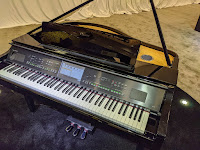 Also, Yamaha (and others) knows that wood is the best transmitter of natural sound in an acoustic piano utilizing a wood soundboard and other wood resonating parts like a wooden chamber within the piano, wooden cabinet, wood outer and inner rims, and other wood components. These things add to the “presence,” natural vibrations, and natural resonances of the piano sound that you can hear and feel. So with that in mind, Yamaha decided to use a spruce wood speaker cone in their Clavinova CLP-785 and CLP-795GP to put out a more natural “wood type” tone is those models. So rather than incorporating a real wood soundboard (like the Kawai company has in their two top hybrid upright models), Yamaha added wood in a separate speaker cone in these 2 models to put out a more organic piano sound along with using regular non-wood speakers.
Also, Yamaha (and others) knows that wood is the best transmitter of natural sound in an acoustic piano utilizing a wood soundboard and other wood resonating parts like a wooden chamber within the piano, wooden cabinet, wood outer and inner rims, and other wood components. These things add to the “presence,” natural vibrations, and natural resonances of the piano sound that you can hear and feel. So with that in mind, Yamaha decided to use a spruce wood speaker cone in their Clavinova CLP-785 and CLP-795GP to put out a more natural “wood type” tone is those models. So rather than incorporating a real wood soundboard (like the Kawai company has in their two top hybrid upright models), Yamaha added wood in a separate speaker cone in these 2 models to put out a more organic piano sound along with using regular non-wood speakers.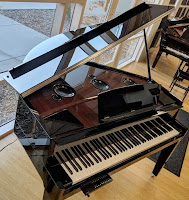 To get even closer to an actual piano playing experience of a real acoustic upright or grand piano, Yamaha also has a line of digital “hybrid” pianos called AvantGrand. There are 4 models in this lineup including one model with an actual (real) Yamaha acoustic upright key action (minus a few parts) called the NU1XA ($7799) and 3 models using a real Yamaha acoustic grand piano key action (minus a few parts) called N1X ($9799) upright style cabinet, N2 ($11,999) upright style cabinet, and N3X ($17,799) full 4′ deep mini grand piano cabinet.
To get even closer to an actual piano playing experience of a real acoustic upright or grand piano, Yamaha also has a line of digital “hybrid” pianos called AvantGrand. There are 4 models in this lineup including one model with an actual (real) Yamaha acoustic upright key action (minus a few parts) called the NU1XA ($7799) and 3 models using a real Yamaha acoustic grand piano key action (minus a few parts) called N1X ($9799) upright style cabinet, N2 ($11,999) upright style cabinet, and N3X ($17,799) full 4′ deep mini grand piano cabinet.In other words, the grand key actions in these AvantGrand models are not just the keys themselves but also nearly all of the hundreds of parts that are connected to all the white and black wooden keys in a real Yamaha grand piano. This is the most realistic possible key action you can put into a digital piano and also the most expensive. When it comes to key actions, this is by far the most hybrid that it gets and is for someone who has the budget and really values the most authentic acoustic piano playing experience you can have in a digital upright or grand piano while also getting the “private practice” stereo headphone feature that is found in all digital pianos.
 Kawai – The Kawai company is well known for building real concert quality acoustic grand and upright pianos and have done so for many years. Their piano products are used by piano teachers, musicians, concert artists, universities, studios, and other venues around the world. They have established themselves as one of the premier piano companies and they build some great products. The Kawai “hybrid” digital pianos start with the CA401 at just $3099 which is the lowest priced “hybrid” out of all the major brands. From there it goes up to the CA501, CA701, CA901, the Novus NV5S, and the top-of-the-line Novus NV10S. The CA401 and CA501 have extra long 12″ white wood keys with counter weights in the bass section keys that help those graded weight keys move better.
Kawai – The Kawai company is well known for building real concert quality acoustic grand and upright pianos and have done so for many years. Their piano products are used by piano teachers, musicians, concert artists, universities, studios, and other venues around the world. They have established themselves as one of the premier piano companies and they build some great products. The Kawai “hybrid” digital pianos start with the CA401 at just $3099 which is the lowest priced “hybrid” out of all the major brands. From there it goes up to the CA501, CA701, CA901, the Novus NV5S, and the top-of-the-line Novus NV10S. The CA401 and CA501 have extra long 12″ white wood keys with counter weights in the bass section keys that help those graded weight keys move better.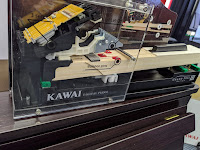
The CA701 and CA901 have extra long nearly 14″ white counter balanced wood keys as well as all wood black keys (most digital pianos have plastic black keys). The CA901 also has that natural acoustic piano “wood sound board” built in that I talked about earlier with transducer microphones attached to that soundboard to bring out the natural tonal vibrations and extra bass response. The Novus NV5S has a full functioning Kawai upright piano key action built in with the hundreds of wood & leather connecting parts that you would find in real Kawai acoustic upright pianos minus the strings and damper mechanisms. The NV10S is like the NV5 but with a full built-in acoustic grand piano key action that comes from a real Kawai acoustic grand piano as opposed to an Kawai acoustic upright key action.
 However, the NV10S does not have a real wood soundboard and instead has an extra large bass speaker to simulate what a wood soundboard would do. I am guessing that Kawai could not physically install a wood soundboard in the NV10S due to the design of that model and instead is relying on the extra large speaker and amplification to take its place. Regardless, all of the Kawai hybrid digital pianos are a joy to play and deserve to be right at the top in their price ranges when it comes to what a piano shopper is looking for. They sound great, look great, play great, and have the latest in digital piano functions and features that can keep a person happy for a very long time.
However, the NV10S does not have a real wood soundboard and instead has an extra large bass speaker to simulate what a wood soundboard would do. I am guessing that Kawai could not physically install a wood soundboard in the NV10S due to the design of that model and instead is relying on the extra large speaker and amplification to take its place. Regardless, all of the Kawai hybrid digital pianos are a joy to play and deserve to be right at the top in their price ranges when it comes to what a piano shopper is looking for. They sound great, look great, play great, and have the latest in digital piano functions and features that can keep a person happy for a very long time.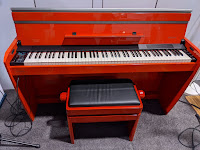 Dexibell – The Dexibell digital piano company is based in Italy and they have their own factory there. Their products are 100% Italian and not made in Asia in a country like many of the other companies do. Dexibell has been in business for a number of years but recently brought their products into the US within the last few years. For 2024 Dexibell is offering their first Hybrid type digital pianos with wooden keys and also a wood soundboard. They have 3 new models called The H10C (console) and the H10MG which is the micro grand version of the H10C, and the lower priced H5 console vertical. The H10C has wooden keys in it there are made by the Fatar key action company, also from Italy. As you can see in the H10C photo (in polished red), the piano is quite contemporary in design and is also offered in three polished finishes at $5999 as well as matte finishes for less money at $4999.
Dexibell – The Dexibell digital piano company is based in Italy and they have their own factory there. Their products are 100% Italian and not made in Asia in a country like many of the other companies do. Dexibell has been in business for a number of years but recently brought their products into the US within the last few years. For 2024 Dexibell is offering their first Hybrid type digital pianos with wooden keys and also a wood soundboard. They have 3 new models called The H10C (console) and the H10MG which is the micro grand version of the H10C, and the lower priced H5 console vertical. The H10C has wooden keys in it there are made by the Fatar key action company, also from Italy. As you can see in the H10C photo (in polished red), the piano is quite contemporary in design and is also offered in three polished finishes at $5999 as well as matte finishes for less money at $4999.
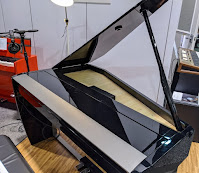 The H10MG micro grand at approx $7999 has the same key action but also a small wooden soundboard for extra resonation, although that soundboard does not have transducer microphones attached to it like Kawai has in their pianos so the Kawai soundboard is more advanced in that way. The Dexibell micro-grand model has approx 15 strategically placed speakers in the piano to recreate the directional and omni-directional sound experience that you would experience in a real acoustic grand piano. At least this is their claim.
The H10MG micro grand at approx $7999 has the same key action but also a small wooden soundboard for extra resonation, although that soundboard does not have transducer microphones attached to it like Kawai has in their pianos so the Kawai soundboard is more advanced in that way. The Dexibell micro-grand model has approx 15 strategically placed speakers in the piano to recreate the directional and omni-directional sound experience that you would experience in a real acoustic grand piano. At least this is their claim.
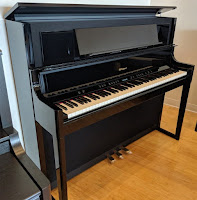 Roland – The Roland company has made digital pianos for many, many years and they have been a top contender when it comes to building quality music products. They also have digital pianos with “hybrid” key actions in them but their digital pianos are the least hybrid of all. Roland has plastic keys and then dresses them up by putting thin wooden sides on the plastic keys so that they look like wood and feel like wood on the sides of the keys but that is the extent of their “hybrid” function and construction.
Roland – The Roland company has made digital pianos for many, many years and they have been a top contender when it comes to building quality music products. They also have digital pianos with “hybrid” key actions in them but their digital pianos are the least hybrid of all. Roland has plastic keys and then dresses them up by putting thin wooden sides on the plastic keys so that they look like wood and feel like wood on the sides of the keys but that is the extent of their “hybrid” function and construction.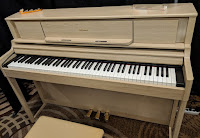 The extra length definitely does not make this key action into a grand piano key action because grand piano keys are far longer than that. In fact, the Kawai all 100% wood white keys in their relatively inexpensive CA401 at just $3099 is a 12′ long white key as compared to the longest hybrid keys of Roland which is a little over 10″ in length and those Roland hybrid grand key pianos sell at a store discount price of about $5000 for their 1st model using their grand key which is more than double the price of the Kawai piano.
The extra length definitely does not make this key action into a grand piano key action because grand piano keys are far longer than that. In fact, the Kawai all 100% wood white keys in their relatively inexpensive CA401 at just $3099 is a 12′ long white key as compared to the longest hybrid keys of Roland which is a little over 10″ in length and those Roland hybrid grand key pianos sell at a store discount price of about $5000 for their 1st model using their grand key which is more than double the price of the Kawai piano.
The Roland pianos with their so-called “hybrid” white keys certainly sell at premium prices considering how little you are getting in terms of the pianos being “hybrid.” There are a lot more functions and features in the new Roland pianos that are pretty cool but those features focus on digital sound and interactive technology and not specifically on the “hybrid” aspect of their pianos.
Hybrid Brands & Models Comparison Facts
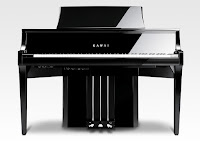 Generally speaking, the top most expensive hybrid digital pianos from the best brands have nearly complete acoustic upright or grand piano key actions in them with not only the real wood piano keys for both black & white keys but also all of the hundreds of moving key action parts with the exceptions of no strings, no felt hammers (because there are no strings for the hammers to strike) no dampers because there are no strings for the dampers to dampen (mute), and no wood soundboards. However, as I mentioned earlier, Kawai has two hybrid models with the inclusion of a wood soundboard with attached transducer microphones to add extra authenticity in tonal frequency and resonation to those pianos. One of those Kawai hybrid soundboard models called the NV5S is an upright digital piano and has all of the key action parts and the other soundboard piano model just has the wooden keys.
Generally speaking, the top most expensive hybrid digital pianos from the best brands have nearly complete acoustic upright or grand piano key actions in them with not only the real wood piano keys for both black & white keys but also all of the hundreds of moving key action parts with the exceptions of no strings, no felt hammers (because there are no strings for the hammers to strike) no dampers because there are no strings for the dampers to dampen (mute), and no wood soundboards. However, as I mentioned earlier, Kawai has two hybrid models with the inclusion of a wood soundboard with attached transducer microphones to add extra authenticity in tonal frequency and resonation to those pianos. One of those Kawai hybrid soundboard models called the NV5S is an upright digital piano and has all of the key action parts and the other soundboard piano model just has the wooden keys.A partial “hybrid” digital piano has all wooden keys, and the longer the key and more wood content in those keys, the more authentic the hybrid piano key action playing experience becomes. Yamaha & Kawai take the top spots for the best hybrid digital piano playing experience closely followed by Casio (which is a lot less money), and then Roland as in last place, which is due to the fact that Roland uses a very minimal amount of wood in their keys (white keys only in all models) and those keys are mostly plastic in content.
Plastic is not a bad thing at all, but just because Roland calls their keys “hybrid keys” does not mean that those keys come anywhere close to the other models from Kawai, Yamaha, and Casio. Yamaha and Kawai design and build real acoustic grand and upright pianos and have done so for many years so they obviously know what they are doing for their top hybrid digital pianos. There are other digital pianos that I have not mentioned in this report because they are portable stage pianos (such as the Kawai MP11SE) and not furniture cabinet pianos.
 There are usually other upgraded differences in many of the hybrid furniture cabinet pianos as compared to regular digital piano models below them in lower price ranges, such as more advanced digital sound technology in the hybrids, upgraded internal speaker systems, more advanced digital features, and even the furniture cabinet design and construction can be upgraded. In fact when it comes to digital interface control panels in their top of the line fully hybrid models (Kawai Novus vs Yamaga AvantGrand), Kawai offers far more advanced technology in that way as compared to Yamaha and Casio. They have a large color touch screen built into the left side of the keyboard that is much easier to use and navigate than the older small button technology of the Yamaha AvantGrand series.
There are usually other upgraded differences in many of the hybrid furniture cabinet pianos as compared to regular digital piano models below them in lower price ranges, such as more advanced digital sound technology in the hybrids, upgraded internal speaker systems, more advanced digital features, and even the furniture cabinet design and construction can be upgraded. In fact when it comes to digital interface control panels in their top of the line fully hybrid models (Kawai Novus vs Yamaga AvantGrand), Kawai offers far more advanced technology in that way as compared to Yamaha and Casio. They have a large color touch screen built into the left side of the keyboard that is much easier to use and navigate than the older small button technology of the Yamaha AvantGrand series.
Kawai also has many more piano sound choices and instrument sounds along with more digital features & functions in their Novus NV5s and NV10s models as compared to Yamaha AvantGrand NU1X, N1X, N2, and N3X. But if you are really focused on the “piano playing experience” then you could easily enjoy either brand of hybrid digital pianos including the new Casio “grand hybrid” models.
Are Hybrid Digital Pianos as Good as Acoustic Pianos?
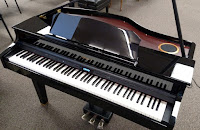 So here’s the bottom line: As much as these digital pianos manufacturers might try to create a digital piano which fully recreates the real acoustic piano playing experience, they are not there yet. They are certainly getting a lot closer, but they have a ways to go. This is because the sound of digital pianos primarily comes through speakers in the piano and this is where the main difference lies, in my opinion. In a real acoustic piano there is a big wooden soundboard which is typically made of natural solid spruce wood. The wood vibrates and amplifies the sound naturally when the strings are vibrating and that natural sound also resonates through the wood body of that acoustic piano.
So here’s the bottom line: As much as these digital pianos manufacturers might try to create a digital piano which fully recreates the real acoustic piano playing experience, they are not there yet. They are certainly getting a lot closer, but they have a ways to go. This is because the sound of digital pianos primarily comes through speakers in the piano and this is where the main difference lies, in my opinion. In a real acoustic piano there is a big wooden soundboard which is typically made of natural solid spruce wood. The wood vibrates and amplifies the sound naturally when the strings are vibrating and that natural sound also resonates through the wood body of that acoustic piano.
With digital pianos, unless it is one of those higher priced acoustic hybrid models, the body is not made of real wood but instead usually made of MDF board. That is fine in terms of cabinet strength and structure but the sound typically does not resonate or vibrate through the cabinet structure on a digital piano. The piano sound in digital pianos mainly comes through electronic amplifiers speakers, and those parts do not amplify and resonate naturally like real wood acoustic pianos with real strings, real wood full size soundboard, and a real wood interior chambers.
Kawai comes a bit closer in a couple of their models such as the CA901 and NV5S which use real wood soundboards that have transducers attached to them to amplify the sound. In reality the tonal vibrations, resonances, echo’s, reverberation, and other organic elements of acoustic pianos are trying to be recreated by digital piano manufacturers in a digital piano but there are limitations to what can be done. So, at least for the experienced pianist, there is still an audible and tactile discernible difference between acoustic pianos and digital pianos including hybrid digital pianos.
Is a Hybrid Digital Piano Worth the Money?
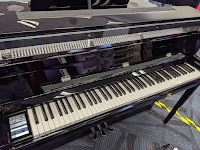 As a long-time experienced piano teacher having taught thousands of students over the years as well as being a pro musician and composer, in my opinion the real question is, can a person who wants a satisfying piano playing experience enjoy playing one of these new hybrid digital pianos or any digital piano and are they worth the money? The answer to that question is absolutely YES! The overwhelming majority of piano players and piano students out there, especially those who play piano recreationally at home, church, school, etc, will enjoy their piano playing experience on these newer upgraded digital pianos as much or more than a traditional acoustic piano for a number of reasons. The key actions are impressive, the newly developed stereo piano sounds are dynamic and expressive, the pedaling is responsive along with longer and more natural sustain-decay times.
As a long-time experienced piano teacher having taught thousands of students over the years as well as being a pro musician and composer, in my opinion the real question is, can a person who wants a satisfying piano playing experience enjoy playing one of these new hybrid digital pianos or any digital piano and are they worth the money? The answer to that question is absolutely YES! The overwhelming majority of piano players and piano students out there, especially those who play piano recreationally at home, church, school, etc, will enjoy their piano playing experience on these newer upgraded digital pianos as much or more than a traditional acoustic piano for a number of reasons. The key actions are impressive, the newly developed stereo piano sounds are dynamic and expressive, the pedaling is responsive along with longer and more natural sustain-decay times.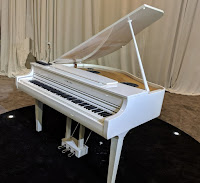 The digital piano never goes out of tune saving you thousands of dollars over the life of the digital piano and always letting you an an “in-tune” playing experience, you can lower the volume with volume control which is especially useful, you can practice in privacy with stereo headphones, you can record yourself in a number of ways for educational purposes, you can connect to Bluetooth audio streaming, MIDI wireless connectivity or musical and educational purposes, and you can use other built-in instrument sounds to enhance your playing enjoyment.
The digital piano never goes out of tune saving you thousands of dollars over the life of the digital piano and always letting you an an “in-tune” playing experience, you can lower the volume with volume control which is especially useful, you can practice in privacy with stereo headphones, you can record yourself in a number of ways for educational purposes, you can connect to Bluetooth audio streaming, MIDI wireless connectivity or musical and educational purposes, and you can use other built-in instrument sounds to enhance your playing enjoyment.If you want more info on new digital pianos and LOWER PRICES than internet discounts, please email me at tim@azpianowholesale.com or call direct at 602-571-1864.




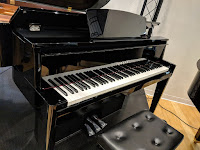












Hello 🙂
I just saw Roland published a new GP-9(M) that are quite pricey… Are they any valuable or is it marketing?
Thx a lot